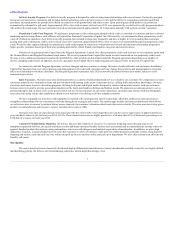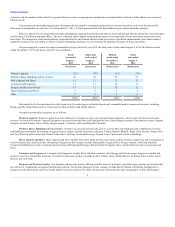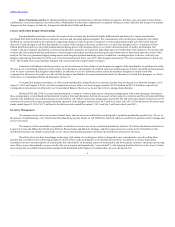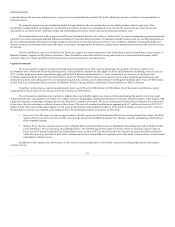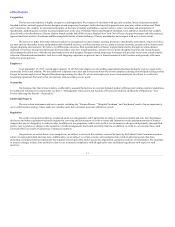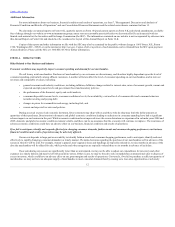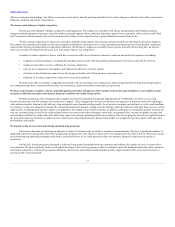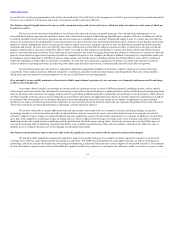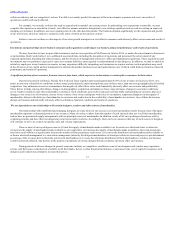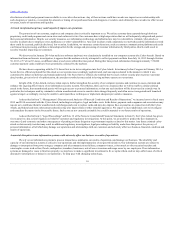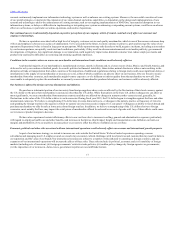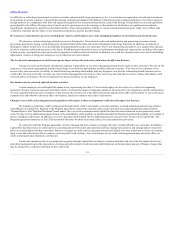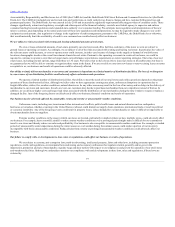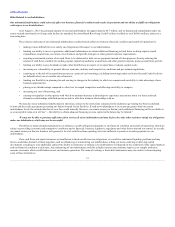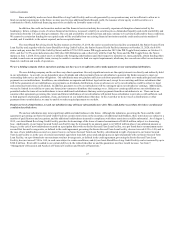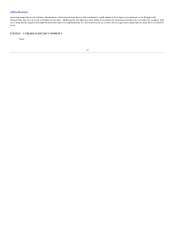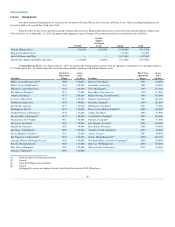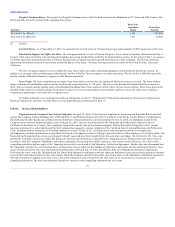Neiman Marcus 2014 Annual Report Download - page 18
Download and view the complete annual report
Please find page 18 of the 2014 Neiman Marcus annual report below. You can navigate through the pages in the report by either clicking on the pages listed below, or by using the keyword search tool below to find specific information within the annual report.
Table of Contents
we must continuously implement new information technology systems as well as enhance our existing systems. Moreover, the successful execution of some
of our growth strategies, in particular the expansion of our omni‑channel and online capabilities, is dependent on the design and implementation of new
systems and technologies and/or the enhancement of existing systems, such as our ongoing implementation of NMG One. Any material disruption in our
information systems, or delays or difficulties in implementing or integrating new systems or enhancing or expanding current systems, could have an adverse
effect on our business, in particular our online operations, and results of operations.
Our continued success is substantially dependent on positive perceptions of our company, which, if eroded, could adversely affect our customer and
employee relationships.
We have a reputation associated with a high level of integrity, customer service and quality merchandise, which is one of the reasons customers shop
with us and employees choose us as a place of employment. To be successful in the future, we must continue to preserve, grow and leverage the value of our
reputation. Reputational value is based in large part on perceptions. While reputations may take decades to build, negative incidents, including actions taken
by our business partners, can quickly erode trust and confidence, particularly if they result in adverse mainstream and social media publicity, governmental
investigations or litigation. Any significant damage to our reputation could negatively impact sales, diminish customer trust, reduce employee morale and
productivity and lead to difficulties in recruiting and retaining qualified employees.
Conditions in the countries where we source our merchandise and international trade conditions could adversely affect us.
A substantial majority of our merchandise is manufactured overseas, mostly in Europe and, to a lesser extent, China, Mexico and South America, and
delivered to us by our vendors as finished goods. As a result, political or financial instability, labor strikes, natural disasters or other events resulting in the
disruption of trade or transportation from other countries or the imposition of additional regulations relating to foreign trade could cause significant delays or
interruptions in the supply of our merchandise or increase our costs, either of which could have an adverse effect on our business. If we are forced to source
merchandise from other countries, such merchandise might be more expensive or of a different or inferior quality from the merchandise we now sell. If we
were unable to adequately replace the merchandise we currently source with merchandise produced elsewhere, our business could be adversely affected.
Our business is affected by foreign currency fluctuations and inflation.
We purchase a substantial portion of our inventory from foreign suppliers whose costs are affected by the fluctuation of their local currency against
the U.S. dollar or who price their merchandise in currencies other than the U.S. dollar. While fluctuations in the Euro-U.S. dollar exchange rate can affect us
most significantly, we source merchandise from numerous countries and thus are affected by changes in numerous other currencies and, generally, by
fluctuations in the value of the U.S. dollar relative to such currencies. During fiscal year 2015, the U.S. dollar began to strengthen against the Euro and other
international currencies. We believe a strengthening U.S. dollar may (i) create disincentives to, or changes in the pattern, practice or frequency of, travel to
and spending by foreign tourists in the regions in which we operate our retail stores and (ii) impact U.S. consumers’ willingness or ability to travel abroad and
purchase merchandise we offer for sale at lower prices from foreign retailers. In addition, we believe a strengthening of the U.S. dollar relative to foreign
currencies, most notably the Euro, may impact the retail prices of merchandise offered for sale and/or our cost of goods sold. Any of these effects could cause
our revenues or product margins to decrease.
We have also experienced certain inflationary effects in our cost base due to increases in selling, general and administrative expenses, particularly
with regard to employee health care and other benefits, and increases in fuel prices, which impact freight and transportation costs. Inflation can harm our
margins and profitability if we are unable to increase prices or cut costs to offset the effects of inflation in our cost base.
Economic, political and other risks associated with our international operations could adversely affect our revenues and international growth prospects.
As part of our business strategy, we intend to increase our sales outside the United States. We have limited experience operating overseas
subsidiaries and managing non‑U.S. employees and, as a result, may encounter cultural challenges with local practices and customs that may result in harm to
our reputation and the value of our brands. Our international revenues are subject to a number of risks inherent to operating in foreign countries, and any
expansion of our international operations will increase the effects of these risks. These risks include: (i) political, economic and civil instability of foreign
markets (including acts of terrorism); (ii) foreign governments’ restrictive trade policies; (iii) sudden policy changes by foreign agencies or governments;
(iv) the imposition of, or increase in, duties, taxes, government royalties or non‑tariff trade barriers;
17


